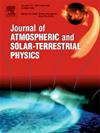Observation and simulation studies of ionospheric F-region in the South American and Antarctic sectors in the intense geomagnetic storm of August 2018
IF 1.8
4区 地球科学
Q3 GEOCHEMISTRY & GEOPHYSICS
Journal of Atmospheric and Solar-Terrestrial Physics
Pub Date : 2025-01-01
DOI:10.1016/j.jastp.2024.106394
引用次数: 0
Abstract
In this investigation, we present and discuss the ionospheric F region observations in the equatorial, low-, mid-, and near high-latitude regions in the South American and Antarctic sectors during the intense geomagnetic storm that occurred on 25–27 August 2018. The geomagnetic storm reached a minimum Dst of −175 nT at ∼0700 UT on 26 August. We present the variations of vertical total electron content (VTEC) from a chain of almost 200 GPS stations, covering the South American and Antarctic sectors. A comparison with model simulations from the Thermosphere Ionosphere Electrodynamics General Circulation Model (TIE-GCM) is realized. The results obtained show that during the main phase of the storm, a southward Bz component of the interplanetary magnetic field (IMF) and an eastward prompt penetration electric field (PPEF) can be observed, but they had no significant impact on the ionospheric plasma. A long recovery phase a predominance of positive phase is observed during daytime. The observations show the effects of an unusual case of multiple PPEF, occurred on 26 August, and effects of thermospheric winds disturbances, occurred on 27 August, resulting in increased VTEC values on both days. The TIE-GCM model reproduces the VTEC increases during the main and recovery phases from mid-latitudes to the equatorial region, but it underestimates the observed values near high-latitudes.
2018年8月强地磁风暴中南美洲和南极扇区电离层f区观测与模拟研究
在本次调查中,我们介绍并讨论了2018年8月25日至27日发生的强烈地磁风暴期间,南美洲和南极板块赤道、低、中、近高纬度地区电离层F区的观测结果。地磁风暴在8月26日~ 0700 UT达到最小Dst为- 175 nT。我们展示了近200个GPS站的垂直总电子含量(VTEC)的变化,覆盖了南美和南极扇区。并与热层电离层电动力学环流模型(TIE-GCM)的模拟结果进行了比较。结果表明,在风暴的主阶段,行星际磁场(IMF)的Bz分量向南,而穿透电场(PPEF)向东,但它们对电离层等离子体的影响不显著。恢复期较长,白天以阳性期为主。观测结果显示,8月26日发生的一次不同寻常的多次极风场的影响和8月27日发生的热层风扰动的影响导致这两天的VTEC值增加。TIE-GCM模式再现了从中纬度到赤道的主要阶段和恢复阶段的VTEC增加,但低估了高纬度附近的观测值。
本文章由计算机程序翻译,如有差异,请以英文原文为准。
求助全文
约1分钟内获得全文
求助全文
来源期刊

Journal of Atmospheric and Solar-Terrestrial Physics
地学-地球化学与地球物理
CiteScore
4.10
自引率
5.30%
发文量
95
审稿时长
6 months
期刊介绍:
The Journal of Atmospheric and Solar-Terrestrial Physics (JASTP) is an international journal concerned with the inter-disciplinary science of the Earth''s atmospheric and space environment, especially the highly varied and highly variable physical phenomena that occur in this natural laboratory and the processes that couple them.
The journal covers the physical processes operating in the troposphere, stratosphere, mesosphere, thermosphere, ionosphere, magnetosphere, the Sun, interplanetary medium, and heliosphere. Phenomena occurring in other "spheres", solar influences on climate, and supporting laboratory measurements are also considered. The journal deals especially with the coupling between the different regions.
Solar flares, coronal mass ejections, and other energetic events on the Sun create interesting and important perturbations in the near-Earth space environment. The physics of such "space weather" is central to the Journal of Atmospheric and Solar-Terrestrial Physics and the journal welcomes papers that lead in the direction of a predictive understanding of the coupled system. Regarding the upper atmosphere, the subjects of aeronomy, geomagnetism and geoelectricity, auroral phenomena, radio wave propagation, and plasma instabilities, are examples within the broad field of solar-terrestrial physics which emphasise the energy exchange between the solar wind, the magnetospheric and ionospheric plasmas, and the neutral gas. In the lower atmosphere, topics covered range from mesoscale to global scale dynamics, to atmospheric electricity, lightning and its effects, and to anthropogenic changes.
 求助内容:
求助内容: 应助结果提醒方式:
应助结果提醒方式:


